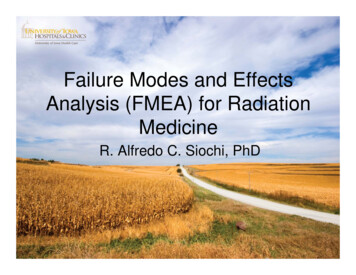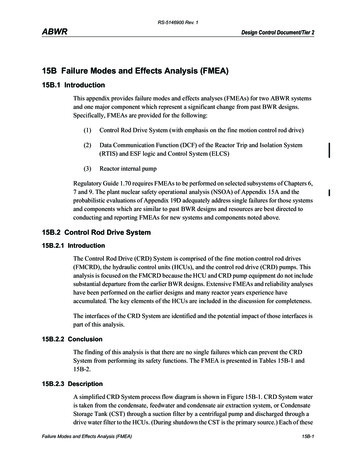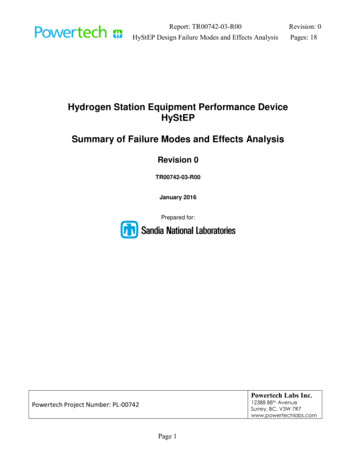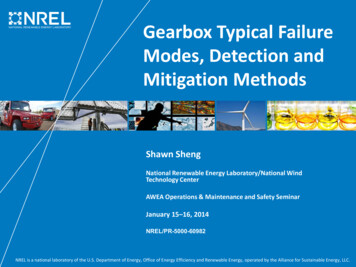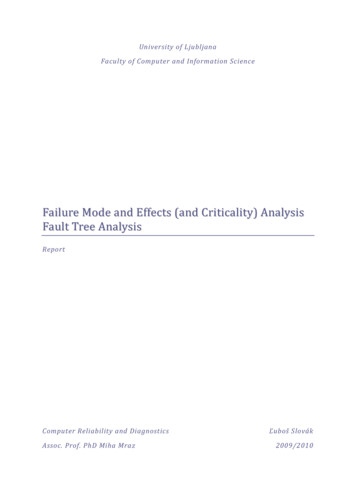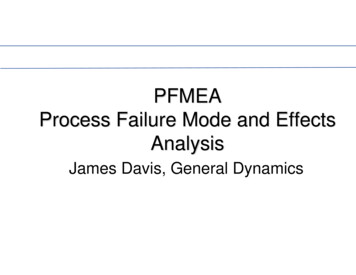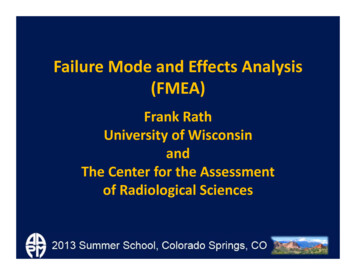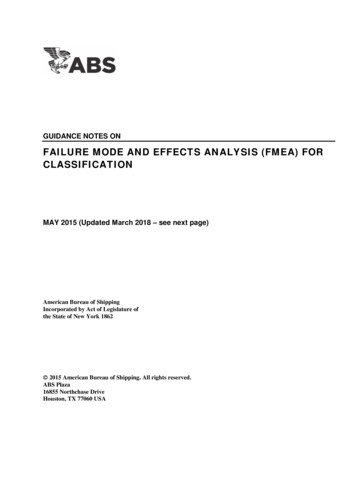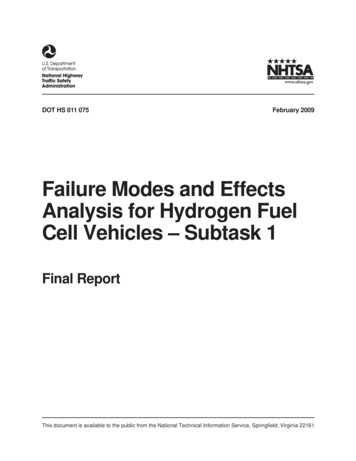
Transcription
DOT HS 811 075February 2009Failure Modes and EffectsAnalysis for Hydrogen FuelCell Vehicles – Subtask 1Final ReportThis document is available to the public from the National Technical Information Service, Springfield, Virginia 22161
DISCLAIMERThis publication is distributed by the U.S. Department of Transportation, NationalHighway Traffic Safety Administration, in the interest of information exchange.The opinions, findings, and conclusions expressed in this publication are those ofthe authors and not necessarily those of the Department of Transportation or theNational Highway Traffic Safety Administration. The United States Governmentassumes no liability for its contents or use thereof. If trade names, manufacturers’names, or specific products are mentioned, it is because they are consideredessential to the object of the publication and should not be construed as anendorsement. The United States Government does not endorse products ormanufacturers.
TECHNICAL REPORT DOCUMENTATION PAGE1.Report No.2.Government Accession No.3.Recipient's Catalog No.5.Report Date6.Performing Organization Code8.Performing Organization Report No.Work Unit No. (TRAIS)DOT HS 811 0754.Title and SubtitleFailure Modes and Effects Analysis for Hydrogen Fuel Cell Vehicles – Subtask 17.Author(s)February 2009Denny R. Stephens, Susan E. Rose, Stephanie A. Flamberg, Stephen M. Ricci, andPaul E. George II9.12.Performing Organization Name and Address10.Battelle Memorial Institute505 King AveColumbus, OH 4320111.Sponsoring Agency Name and Address13.National Highway Traffic Safety Administration1200 New Jersey Avenue SE.Washington, DC 2059015.16.Contract or Grant No.DTNH22-02-D-02104Type of Report and Period CoveredFinal14.Sponsoring Agency CodeOffice of Applied VehicleSafety Research – Structuresand Restraints ResearchDivision, NVS-321Supplementary NotesAbstractHydrogen fuel cell vehicles (HFCVs) offer the promise of significantly reducing the amount of pollutantsexpelled into the environment. However, the technology that is needed to store the hydrogen fuel onboardand deliver it to the propulsion system is different from what consumers and even engineers currentlyknow and understand. As an early step in identifying critical safety requirements for these vehicles and, ifneeded, developing appropriate Federal Motor Vehicle Safety Standards, the National Highway TrafficSafety Administration requested that Battelle undertake a high-level failure modes and effects analysis tocharacterize potential hazards from compressed-hydrogen fuel cell vehicles and identify potential safetyissues. The objective of this effort is to review and assesses safety issues for hydrogen vehicles and toidentify areas that NHTSA may consider addressing in the FMVSS.The investigation found that, overall, the failure modes that appear to have the greatest hazard in hydrogenvehicles are large releases of hydrogen and rupture of the fuel container. The FMEA results show that ifhigh-pressure components in compressed-hydrogen fuel systems lack redundancy, a single-point failure ofthe container, PRD, or first valve, can result in a large-scale release or venting of hydrogen and, forcontainers, release of mechanical energy. Small releases of hydrogen and rupture of other componentsmay also be hazardous, but do not have the potential destructive force of large releases and fuel containerrupture.17.Key Words18.Distribution Statementhydrogen, fuel cell, compressed hydrogen, fuel storage, This report is free of charge from the NHTSA Web site atwww.nhtsa.dot.govFMEA, HFCV, risk, hazard19.Security Classif. (of this report)20.Security Classif. (of this page)UnclassifiedForm DOT F 1700.7 (8-72)Failure Modes and Effects Analysisfor Hydrogen Fuel Cell Vehicles21.No. of Pages22.PriceUnclassified170Reproduction of completed page authorizediFebruary 2009Final Report
Failure Modes and Effects Analysisfor Hydrogen Fuel Cell VehiclesiiFebruary 2009Final Report
TABLE OF CONTENTSPageExecutive Summary . vAcronyms and Abbreviations . vii1.0Introduction. 11.1Project Objectives . 11.2Technical Approach . 22.0NHTSA and FMVSS Background. 43.0Elements of Compressed-Hydrogen Fuel Cell Vehicles . 63.1Hydrogen Fueling and Fuel Storage Subsystem. 83.2Hydrogen Fuel Delivery Subsystem . 93.3Fuel Cell Subsystem . 93.4Electric Propulsion and Power Management Subsystem. 104.0Unique Hazards of Compressed-Hydrogen Vehicles . 114.1Combustion Hazards. 114.2High-Pressure Hazards. 144.3Electrical Hazards . 164.4Crash Hazard. 184.5Fire Hazards . 205.0Failure Modes and Effects Analysis of Compressed-Hydrogen Fuel CellVehicle. 215.1Description of the FMEA Development Process. 215.2Description of the Results. 246.0Comparison of FMEA Results With Fuel Cell Vehicle Codes and Standards. 526.1Review of Codes and Standards . 526.2Review of FMEA and Related Codes and Standards . 536.3Potential Gaps in Standards . 727.0Resulting Assessment of Safety Issues. 757.1High-Consequence Failure Modes. 767.2Root Causes and Design Controls. 777.3Highly Variable Hazards. 788.0References . 81Appendix A: Summary of Hydrogen Vehicle Codes and Standards . A-1SAE Recommended Practices. A-1ISO Safety Specifications . A-8CSA Draft Standards. A-13Japanese HFCV Standard . A-16European Working Group. A-19Appendix B: Failure Modes and Effects Analysis of Compressed-Hydrogen FuelCell Vehicles With Codes and Standards . B-1Failure Modes and Effects Analysisfor Hydrogen Fuel Cell VehiclesiiiFebruary 2009Final Report
TABLE OF CONTENTS (Continued)PageList of TablesTable 1.Table 2.Table 3.Table 4.Table 5.Table 6.Table 7.Table 8.Table 9.Organization of FMVSS Standards . 5Comparative Transportation Fuel Properties. 12HFCV Concept Model Systems, Subsystems, and Components. 22Likelihood Categories . 24Consequence Categories. 24FMEA of Compressed-Hydrogen Fuel Cell Vehicle. 28Overview of FCV Codes and Standards. 54Summary of Content of Compressed FCV Codes, Standards, and Analogous FMVSS . 57Summary of HFCV FMEA and Codes and Standards . 61List of FiguresFigure 1. High-Level Schematic of Compressed-Hydrogen Fuel Cell Vehicle Subsystems . 7Figure 2. Schematic of Compressed-Hydrogen Fuel Cell Vehicle Component Locations andMass Distribution. 7Figure 3. Comparison of Fuels on a Mass Energy Density Basis . 15Figure 4. Comparison of Fuels on a Volumetric Energy Density Basis . 15Figure 5. Conventional Time/Current Zones of Effects of AC Currents (15 Hz to 100 Hz) onPersons for a Current Path Corresponding to Left Hand to Feet (Source: IEC 60479-1). 17Figure 6. Conventional Time/Current Zones of Effects of DC Currents on Persons for aLongitudinal Upward Current Path (Source: IEC 60479-1) . 18Figure 7. Schematic of Compressed-Hydrogen Fuel Cell Vehicle Component Locations andMass Distribution. 19Figure 8. Simplified Diagram of Compressed-Hydrogen Fuel Cell Vehicle Systems. 23Figure 9. Risk Matrix . 24Failure Modes and Effects Analysisfor Hydrogen Fuel Cell VehiclesivFebruary 2009Final Report
EXECUTIVE SUMMARYHydrogen-fueled vehicles offer the promise of significantly reducing the amount of pollutantsexpelled into the environment. However, the technology that is needed to store the hydrogenfuel onboard and deliver it to the propulsion system is different from what consumers and evenengineers currently know and understand. As an early step in identifying critical safetyrequirements for these vehicles and, if needed, develop appropriate Federal Motor Vehicle SafetyStandards, the National Highway Traffic Safety Administration requested that Battelle undertakea high-level failure modes and effects analysis to characterize potential hazards fromcompressed-hydrogen fuel cell vehicles and identify potential safety issues. The objective of theeffort reported here is to review and assesses safety issues for hydrogen vehicles and to identifyareas that NHTSA may consider addressing in the FMVSS.Along with NHTSA, other government and industrial organizations are looking closely athydrogen vehicle safety needs and are developing standards for hydrogen vehicle components,integrated subsystems (fuel storage and delivery, electrical, etc.) and fully integrated hydrogenvehicles. It is expected that NHTSA will not need to duplicate the work that is being doneelsewhere to address safety of hydrogen vehicles. Consequently, Battelle has focused thisassessment on two fundamental questions: In its regulatory function, what safety issues should NHTSA consider prioritizing forcompressed-hydrogen vehicles? Are there potential gaps in the coverage of safety standards for compressed-hydrogenvehicles that merit NHTSA’s consideration?To address these challenging questions, Battelle adopted a structured approach that included thefollowing activities. Review of NHTSA’s safety objectives and the general topics addressed by the FMVSS tocharacterize NHTSA’s potential roles in hydrogen safety; Review of the unique elements of compressed-hydrogen vehicles in an effort to narrowthe scope of the assessment to those elements that are unique to hydrogen vehicles; Review of the unique hazards of compressed-hydrogen vehicles; Failure modes and effects analysis of a conceptual compressed-hydrogen fuel cell vehicleto characterize potential hazards and potential controls to mitigate these hazards; and Comparison of the results of the FMEA with fuel cell vehicle codes and standards toidentify potential gaps in safety coverage that may need to be considered.The conclusions of the investigation centered on high-consequence failure modes, root causes offailure, design controls to reduce the likelihood of failure, and potential gaps in the current codesand standards.Failure Modes and Effects Analysisfor Hydrogen Fuel Cell VehiclesvFebruary 2009Final Report
The investigation found that, overall, the unique failure modes that appear to have the greatesthazard i
depending on the circumstances. Secondary failure modes considered include failure of PRDs or valves to open or close when required. Industry codes and standards currently exist or are in development to address the design, manufacture, installation, and integration for the safe use of compressed-hydrogen fuel containers. However there is currently no FMVSS specific to the concerns related to
